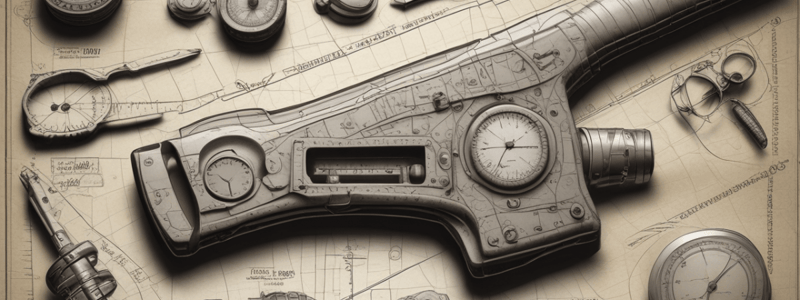Podcast
Questions and Answers
EASY What is the purpose of adding the thimble division to the first two measurements?
EASY What is the purpose of adding the thimble division to the first two measurements?
- To convert the measurement to inches
- To find the total measurement in millimeters (correct)
- To determine the micrometer's precision
- To calculate the minor barrel divisions
Why should a micrometer be handled with care?
Why should a micrometer be handled with care?
- To improve its accuracy
- To reduce the risk of damage to its fine parts (correct)
- To prevent corrosion
- To maintain its precision over time
What is the recommended way to store a micrometer?
What is the recommended way to store a micrometer?
- On a workbench
- In a toolbox
- In a drawer
- In its proper case (correct)
What is the main use of feeler gauges?
What is the main use of feeler gauges?
How should feeler gauges be maintained?
How should feeler gauges be maintained?
What is the primary purpose of measuring tools?
What is the primary purpose of measuring tools?
What type of measurement tool is used for coarse measurements?
What type of measurement tool is used for coarse measurements?
How should a steel scale be stored?
How should a steel scale be stored?
What can cause corrosion on a steel scale?
What can cause corrosion on a steel scale?
What is the purpose of the power rewind mechanism in steel tapes?
What is the purpose of the power rewind mechanism in steel tapes?
What is the maximum distance that the working parts of a micrometer can move?
What is the maximum distance that the working parts of a micrometer can move?
What is the purpose of the ratchet stop in a micrometer?
What is the purpose of the ratchet stop in a micrometer?
How should the distance on a micrometer be read?
How should the distance on a micrometer be read?
MEDIUM What is the main advantage of using a micrometer over a steel scale?
MEDIUM What is the main advantage of using a micrometer over a steel scale?
Why should a steel tape be rewound slowly?
Why should a steel tape be rewound slowly?
What is the purpose of the anvil on a micrometer?
What is the purpose of the anvil on a micrometer?
What is the unit of measurement for a steel scale?
What is the unit of measurement for a steel scale?
How should a steel scale be maintained?
How should a steel scale be maintained?
What is the maximum range of a 200 mm micrometer?
What is the maximum range of a 200 mm micrometer?
Why should a micrometer be handled with care?
Why should a micrometer be handled with care?
What is the primary function of the sleeve or barrel on a micrometer?
What is the primary function of the sleeve or barrel on a micrometer?
What is the unit of measurement for the major barrel divisions in a micrometer?
What is the unit of measurement for the major barrel divisions in a micrometer?
What is the primary purpose of keeping a micrometer away from dirt, grit, grease, and moisture?
What is the primary purpose of keeping a micrometer away from dirt, grit, grease, and moisture?
What is the purpose of applying a thin coat of oil to the leaves of feeler gauges?
What is the purpose of applying a thin coat of oil to the leaves of feeler gauges?
What is the total measurement obtained from the micrometer reading?
What is the total measurement obtained from the micrometer reading?
What is the unit of measurement for the thimble divisions in a micrometer?
What is the unit of measurement for the thimble divisions in a micrometer?
HARD What is the primary reason for keeping a micrometer away from dirt, grit, grease, and moisture?
HARD What is the primary reason for keeping a micrometer away from dirt, grit, grease, and moisture?
What is the primary function of the leaves in feeler gauges?
What is the primary function of the leaves in feeler gauges?
What is the unit of measurement for the minor barrel divisions in a micrometer?
What is the unit of measurement for the minor barrel divisions in a micrometer?
What is the purpose of controlling the rate of rewinding a steel tape?
What is the purpose of controlling the rate of rewinding a steel tape?
What is the purpose of occasionally applying a thin coat of oil to the leaves of feeler gauges?
What is the purpose of occasionally applying a thin coat of oil to the leaves of feeler gauges?
What is the function of the spindle in a micrometer?
What is the function of the spindle in a micrometer?
What is the total measurement obtained from the micrometer reading?
What is the total measurement obtained from the micrometer reading?
Why should a steel scale be wiped with light oil?
Why should a steel scale be wiped with light oil?
What is the primary advantage of using a micrometer over a steel scale?
What is the primary advantage of using a micrometer over a steel scale?
What is the purpose of the frame in a micrometer?
What is the purpose of the frame in a micrometer?
Why should a micrometer be handled with care?
Why should a micrometer be handled with care?
What is the unit of measurement for the minor divisions on a micrometer?
What is the unit of measurement for the minor divisions on a micrometer?
What is the primary reason for storing a steel scale in a protective case?
What is the primary reason for storing a steel scale in a protective case?
Flashcards are hidden until you start studying
Study Notes
Measuring Tools
- Measuring tools are used to determine the dimensions of an object
- Coarse measurements can be made using a steel scale or tape
- Fine measurements require a micrometer or vernier caliper
Steel Scales and Tapes
- A steel scale is a flat metal ruler with edges calibrated in millimeters and sixteenths of an inch
- Measurements must be taken perpendicular to the surface to avoid inaccuracy
- Steel scales should be stored carefully to avoid damage and wiped with light oil to prevent corrosion from fingerprints
Steel Tapes
- Most steel tapes have a power rewind mechanism built into them
- Damage can occur if rewound too quickly
- Controlling the rewinding rate by guiding the tape with your free hand can prevent damage
Micrometers
- Micrometers are used for precise measurements with a fine degree of precision and minimal error
- Micrometers come in various sizes (25 mm to 300 mm) but can only move 25 mm
- Different types of micrometers include outside, inside, screw thread, and depth micrometers
Micrometer Parts
- Main parts of a micrometer include the frame, anvil, spindle, sleeve or barrel, thimble, and ratchet stop
Reading a Micrometer
- Read the major barrel divisions first, then add minor divisions and thimble divisions for an accurate measurement
- Example: 17.51 mm (17.0 mm + 0.50 mm + 0.01 mm)
Caring for Micrometers
- Micrometers should be handled with care to avoid damage from drops or exposure to dirt, grit, grease, and moisture
- Store micrometers in their proper case and apply a thin coat of oil occasionally to protect from corrosion
Feeler Gauges
- Feeler gauges, or thickness gauges, are used to check bearing clearances, gear play, and measure narrow slots and gaps
- They are also used to check spark plug gaps and tappet valve clearances
- Keep feeler gauges clean and occasionally apply a thin coat of oil to the leaves
Measuring Tools
- Measuring tools are used to determine the dimensions of an object
- Coarse measurements can be made using a steel scale or tape
- Fine measurements require a micrometer or vernier caliper
Steel Scales and Tapes
- A steel scale is a flat metal ruler with edges calibrated in millimeters and sixteenths of an inch
- Measurements must be taken perpendicular to the surface to avoid inaccuracy
- Steel scales should be stored carefully to avoid damage and wiped with light oil to prevent corrosion from fingerprints
Steel Tapes
- Most steel tapes have a power rewind mechanism built into them
- Damage can occur if rewound too quickly
- Controlling the rewinding rate by guiding the tape with your free hand can prevent damage
Micrometers
- Micrometers are used for precise measurements with a fine degree of precision and minimal error
- Micrometers come in various sizes (25 mm to 300 mm) but can only move 25 mm
- Different types of micrometers include outside, inside, screw thread, and depth micrometers
Micrometer Parts
- Main parts of a micrometer include the frame, anvil, spindle, sleeve or barrel, thimble, and ratchet stop
Reading a Micrometer
- Read the major barrel divisions first, then add minor divisions and thimble divisions for an accurate measurement
- Example: 17.51 mm (17.0 mm + 0.50 mm + 0.01 mm)
Caring for Micrometers
- Micrometers should be handled with care to avoid damage from drops or exposure to dirt, grit, grease, and moisture
- Store micrometers in their proper case and apply a thin coat of oil occasionally to protect from corrosion
Feeler Gauges
- Feeler gauges, or thickness gauges, are used to check bearing clearances, gear play, and measure narrow slots and gaps
- They are also used to check spark plug gaps and tappet valve clearances
- Keep feeler gauges clean and occasionally apply a thin coat of oil to the leaves
Measuring Tools
- Measuring tools are used to determine the dimensions of an object
- Coarse measurements can be made using a steel scale or tape
- Fine measurements require a micrometer or vernier caliper
Steel Scales and Tapes
- A steel scale is a flat metal ruler with edges calibrated in millimeters and sixteenths of an inch
- Measurements must be taken perpendicular to the surface to avoid inaccuracy
- Steel scales should be stored carefully to avoid damage and wiped with light oil to prevent corrosion from fingerprints
Steel Tapes
- Most steel tapes have a power rewind mechanism built into them
- Damage can occur if rewound too quickly
- Controlling the rewinding rate by guiding the tape with your free hand can prevent damage
Micrometers
- Micrometers are used for precise measurements with a fine degree of precision and minimal error
- Micrometers come in various sizes (25 mm to 300 mm) but can only move 25 mm
- Different types of micrometers include outside, inside, screw thread, and depth micrometers
Micrometer Parts
- Main parts of a micrometer include the frame, anvil, spindle, sleeve or barrel, thimble, and ratchet stop
Reading a Micrometer
- Read the major barrel divisions first, then add minor divisions and thimble divisions for an accurate measurement
- Example: 17.51 mm (17.0 mm + 0.50 mm + 0.01 mm)
Caring for Micrometers
- Micrometers should be handled with care to avoid damage from drops or exposure to dirt, grit, grease, and moisture
- Store micrometers in their proper case and apply a thin coat of oil occasionally to protect from corrosion
Feeler Gauges
- Feeler gauges, or thickness gauges, are used to check bearing clearances, gear play, and measure narrow slots and gaps
- They are also used to check spark plug gaps and tappet valve clearances
- Keep feeler gauges clean and occasionally apply a thin coat of oil to the leaves
Studying That Suits You
Use AI to generate personalized quizzes and flashcards to suit your learning preferences.




